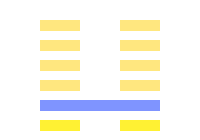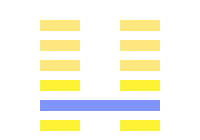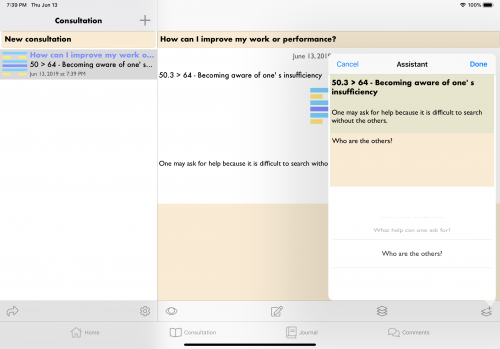A promising methodology for interpreting multiple changing lines
While the interpretation of unchanging hexagrams and single changing line hexagrams, it has always been difficult to interpret multiple lines.
Several methods have been suggested, which all gave mixed results. Sometimes they were encouraging, and sometimes they were discouraging.
As I have been busy working on multiple line comments, by the mean of consulting the oracle, and by following a particular method, I have been unable so far to describe a proper method for interpreting multiple lines.
When consulted, the oracle hinted with 63.3:


Situation
One is hard at work to solve a problem, it will be painful. The most able will go first.
I have interpreted this as the topmost line was the most important, thus should be interpreted first.
This gave me some good results with two changing lines, the topmost line was to be read first, then the bottom line. For example 7.1.2:


Situation
7 > 24 - Not being taken immediately
One must show to their relatives that they are ready to respect the choice of others.
The formation
7 - The will
To solve their problems, one will need discipline and continuity.
You would read the comment for the second line first:
One does like everybody else, therefore is trusted.
then the comment for the first line:
Contradictions show falsity.
Since the first line amends the second, this can be interpreted as "everyone should be allowed to contradict others", and we have this comment on the situation:
One must show to their relatives that they are ready to respect the choice of others.
This is compatible with the interpretation we have just made.
What about 3 or more changing lines?
My first idea was to use transitional changes, I have written an article about them here.
However, we have just seen that using transitional changes was not necessary for two lines. Would they be useful for three or more changing lines? Actually, I don't think so.
For example, let's check the transformations for 7.1.2.3:


Situation
One goes further than those who have been afraid to face the unknown.
So, my first idea was to read the comment for 7.3, since the oracle commented that the most able should go first. Then I would read the comment for 46.2 since 7.3 > 46 and finally 15.1 since 46.2 > 15. So, roughly:
One gives up making a gesture of staying in place.
This is quite compatible with the comment on the situation. Of course, we can criticize "the gesture of staying in place" as being meaningless.
Alternatively, we could use the comment on 7.1.2 to interpret 7.1.2.3:
One gives up on others. (7.3)
One must show to their relatives that they are ready to respect the choice of others. (7.1.2)
That does not help... Finally we can use the comment on 7.2.3 to interpret 7.1.2.3:
One warns those who seek to stand out. (7.2.3)
Contradictions show falsity. (7.1)
And this makes perfect sense. Someone contradicts those who warn against standing out. In my opinion, the rest of the comment (facing the unknown) can be explained by the resulting hexagram 36.
So, the correct method would be to use the transformation of all lines except the bottom one amended by the bottom line.
We can verify with 7.1.2.3.4:
One explains to their opponents that it is necessary to find a compromise.
The 2 comments to take into consideration being:
One is in a hurry to leave when things have a reached such a level that one can no longer resist. (7.2.3.4)
Contradictions show falsity. (7.1)
So, if one can still resist but also shows signs of fatigue, it may be necessary to find a compromise.
We can also verify 7.1.2.3.4.5:
One joins those who want to highlight the most deserving.
One sends their friends to inform those who are wondering. (7.2.3.4.5)
Contradictions show falsity. (7.1)
While the two first comments have a similar tone, the influence of 7.1 is more difficult to catch. My interpretation is that those who are wondering are not really wondering, so they help highlighting the most deserving (for example with prepared questions).
Finally, we can have a look at 7.1.2.3.4.5.6, since we have all the comments for hexagram 7:
One had expected better conditions than those that really occurred.
One wants to learn the reason why the opponents have eventually agreed. (7.2.3.4.5.6)
Contradictions show falsity. (7.1)
So, if we interpret this as "the opponents did not really agree", the comments are compatible here.
Conclusion
This methodology does not give a straight explanation of the comments on the situation. However it can be completed by the study of the two hexagrams, and also by the nuclear hexagram. Compared to using the transitional sequences, it offers little contradictions or conflicting interpretations (such as 46.2 mixed with 15.1). It is important to find the right methodology to demonstrate the validity of the comments on the situation, and eventually find errors. As we have seen with the difficulty of interpreting 7.1 in 7.1.2.3.4.5, the interpretation can be fragile, and thus questionable. However this method appears to be the most promising to me, as of today.

